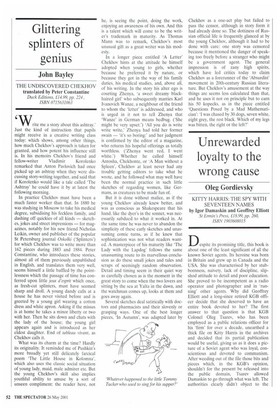Glittering splinters of genius
John Bayley
THE UNDISCOVERED CHEKHOV translated by Peter Constantine Duck Editions, £14.99, pp. 224, ISBN 0715631063 Write me a story about this ashtray.' Just the kind of instruction that pupils might receive in a creative writing class today: which shows, among other things, how much Chekhov's approach is taken for granted, and how potent his influence still is. In his memoirs Chekhov's friend and
fellow-writer Vladimir Korolenko remarked that Anton Pavlovich had once picked up an ashtray when they were discussing story-writing together, and said that if Korolenko would like a tale called The Ashtray' he could have it by at latest the following morning.
In practice Chekhov must have been a much faster worker than that. In 1880 he was studying in Moscow to take his medical degree, subsidising his feckless family, and dashing off quickies of all kinds — sketches, jokes and street impressions — for magazines, notably for his new friend Nicholas Leikin, owner and publisher of the popular St Petersburg journal Oskolki (Splinters') for which Chekhov was to write more than 162 pieces during 1883 and 1884. Peter Constantine, who introduces these stories, almost all of them previously unpublished in English, and translates them very well, seems himself a little baffled by the pointlessness which the passage of time has conferred upon little jeux &esprit which once, as fresh-cut splinters, must have seemed sharp and droll. A young dandy calls at a house he has never visited before and is greeted by a young girl wearing a cotton dress and white apron. Asking if the missus is at home he takes a minor liberty or two with her. Then he sits down and chats with the lady of the house; the young girl appears again and is introduced as her eldest daughter. End of tableau vivant, as Chekhov calls it.
What was its charm at the time? Hardly its originality. It reminded me of Pushkin's more broadly yet still delicately farcical poem 'The Little House in Kolomna', which also uses the classic social situation of young lady, maid, male admirer etc. But the young Chekhov's skill also implies youthful ability to amuse by a sort of unseen compliment: the reader here, not he, is seeing the point, doing the work, enjoying an awareness of his own. And this is a talent which will come to be the writer's trademark in maturity. As Thomas Mann was to remark, Chekhov's most unusual gift as a great writer was his modesty.
In a longer piece entitled 'A Letter' Chekhov hints at the attitude he himself adopted when young to girls, whether because he preferred it by nature, or because they got in the way of his family duties, his medical studies, and, above all, of his writing. In the story his alter ego is courting Zhenya, 'a sweet dreamy blackhaired girl' who subsequently marries Karl Ivanovich Wanze, a neighbour of the friend to whom the 'letter' is addressed, and who is urged in it not to tell Zhenya that `Wanze' in German means bedbug. ('She might be very upset') 'All you do is write write write,' Zhenya had told her former swain — 'it's so boring:' and her judgment is confirmed by the editor of a magazine, who returns his hopeful offerings as totally worthless. ('Zhenya went red, I went white.') Whether he called himself Antosha, Chekhonte, or 'A Man without a Spleen', Chekhov at least never had any trouble getting editors to take what he wrote, and he followed what may well have been the normal practice in such little sketches of regarding women, like Germans, as creatures to be made fun of.
But it is done without malice, as if the young Chekhov already knew better, and was as conscious as Shakespeare that his hand, like the dyer's in the sonnet, was necessarily subdued to what it worked in. At the same time he was never to abandon the simplicity of these early sketches and unassuming comic turns, as if he knew that sophistication was not what readers wanted. A masterpiece of his maturity like 'The Lady with the Lapdog' follows the same unassuming route to its marvellous conclusion as do these small jokes and tales and scraps of seemingly random observation. Detail and timing seem in their quiet way as carefully chosen as is the moment in the great story to come when the two lovers are sitting by the sea at Yalta in the dawn, and the watchman comes up, looks at them and goes away again.
Several sketches deal satirically with doctors and pharmacists and their slovenly or grasping ways. One of the best longer pieces, 'In Autumn', was adapted later by Chekhov as a one-act play but failed to pass the censor, although in story form it had already done so. The dottiness of Russian official life is frequently glanced at by the young Chekhov, although it had to be done with care: one story was censored because it mentioned the danger of speaking too freely before a stranger who might be a government agent. The general impression is of zany high spirits, which have led critics today to claim Chekhov as a forerunner of the `Absurdist' movement in 20th-century Russian literature. But Chekhov's amusement at the way things are seems less calculated than that, and he uses it not on principle but to earn his 50 kopecks, as in the piece entitled 'Questions Posed by a Mad Mathematician': 'I was chased by 30 dogs, seven white, eight grey, the rest black. Which of my legs was bitten, the right or the left?'


















































































 Previous page
Previous page